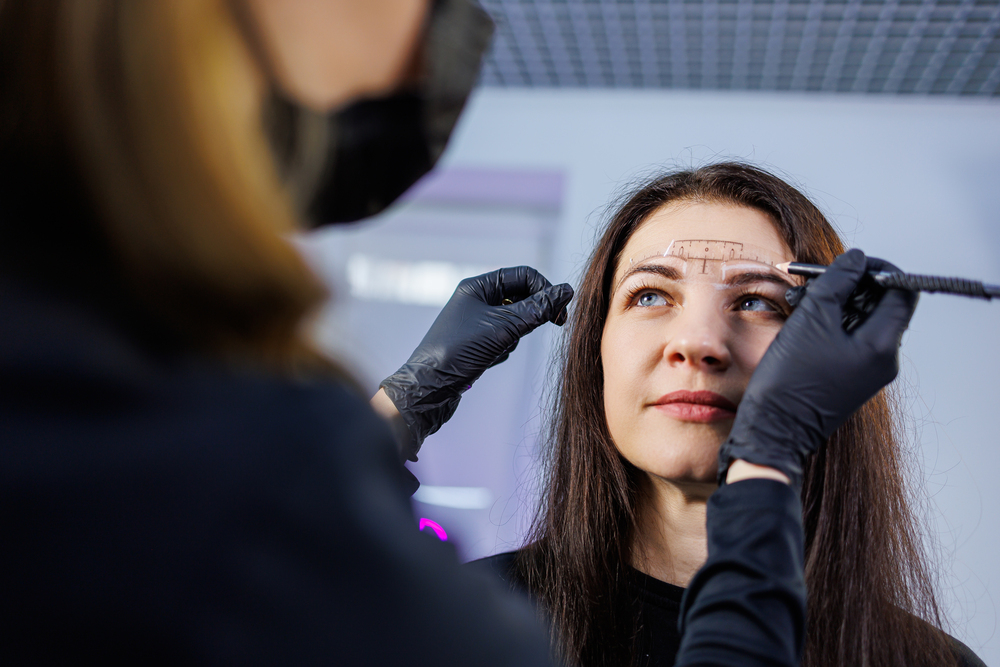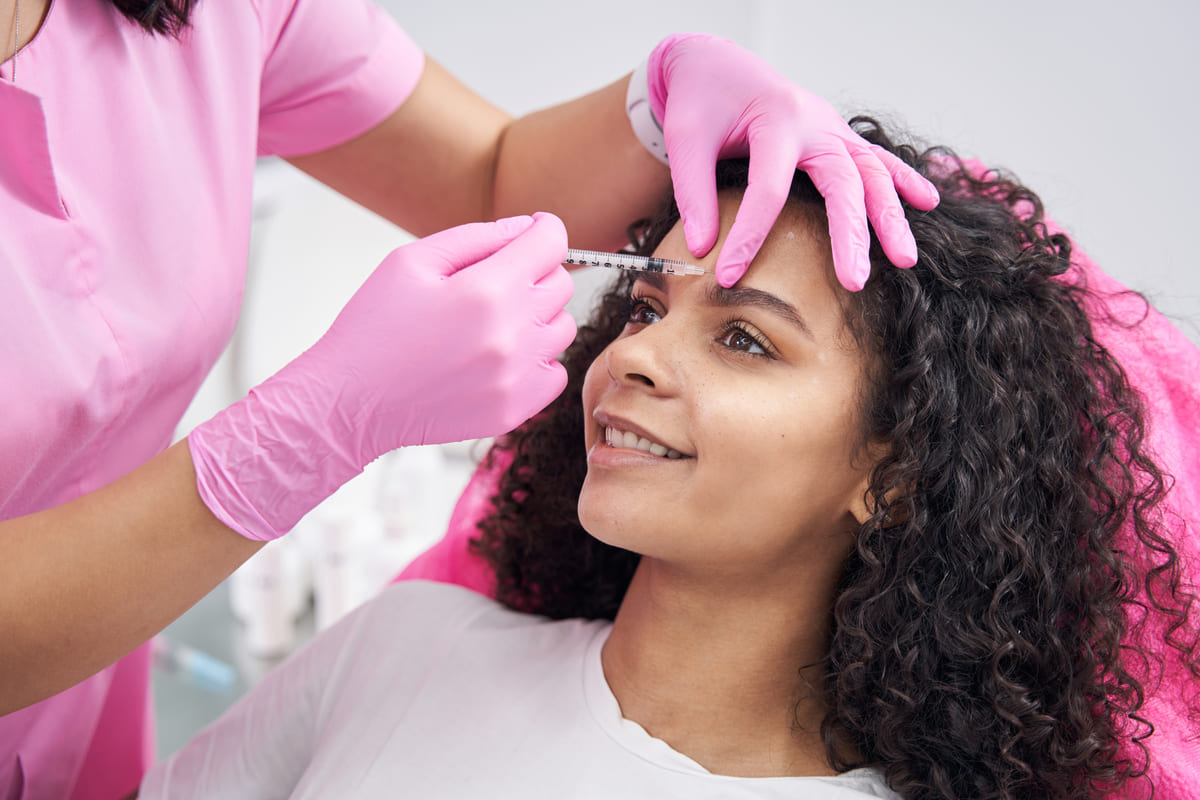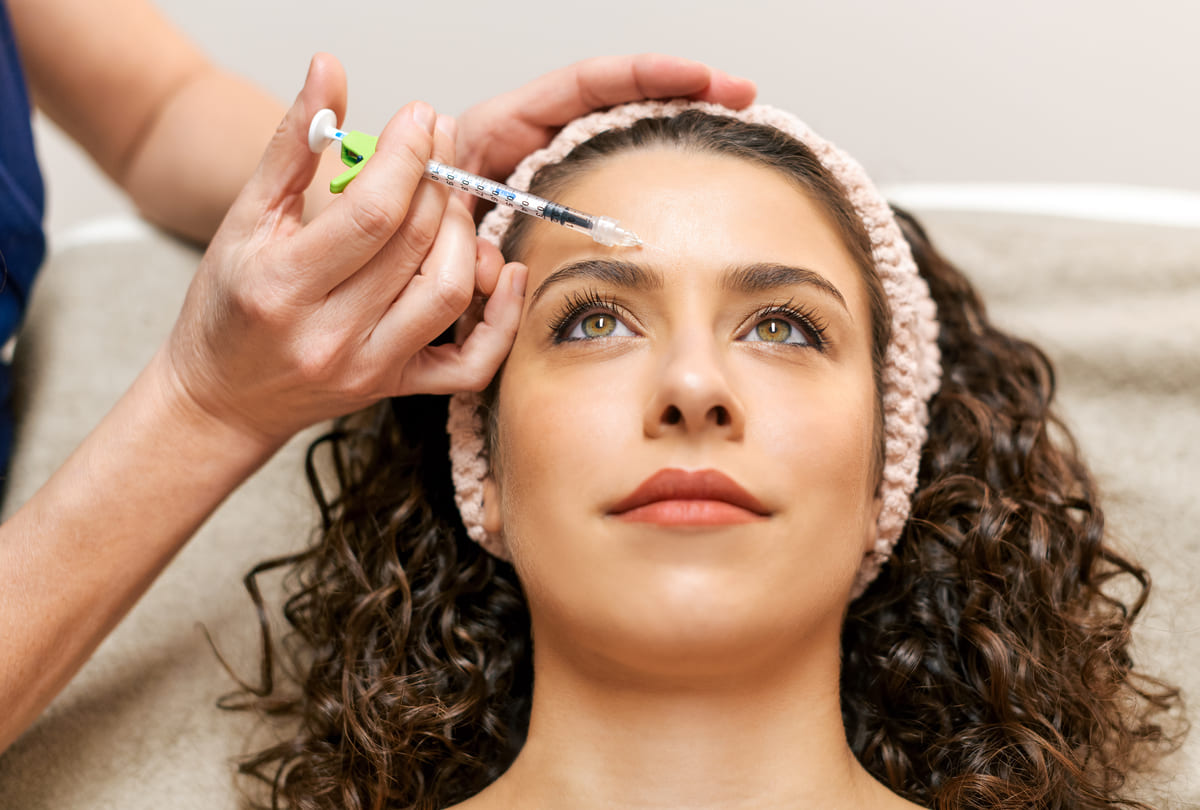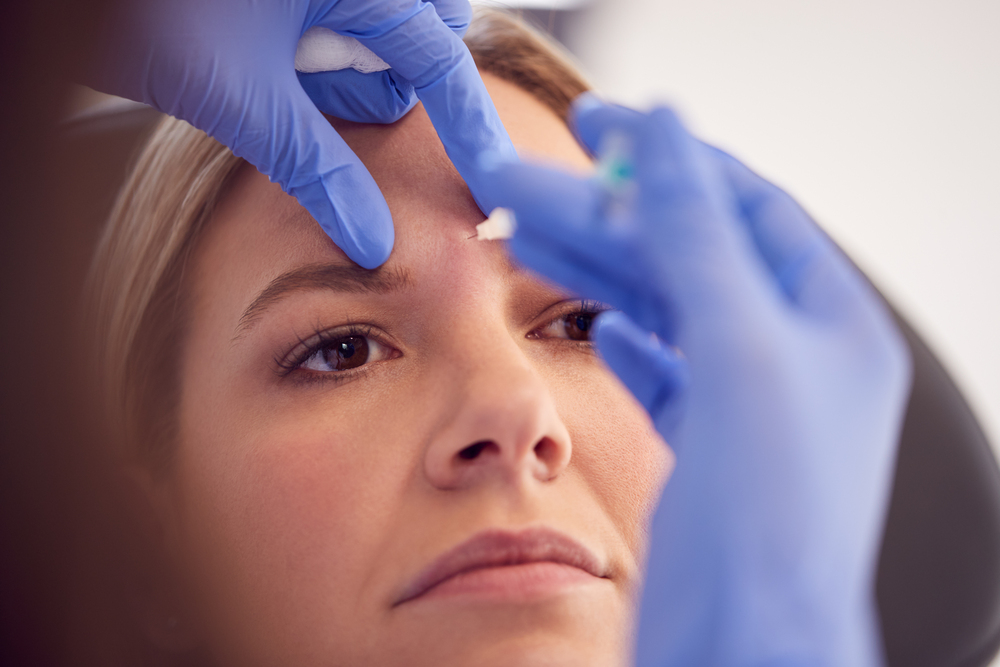Botox is the most common injection doctors use to smooth forehead wrinkles in the United States. In 2019, over 7 million people chose Botox to ease facial lines and calm strong muscle movement. The forehead reacts early because it moves with nearly every expression.
Each treatment uses a small amount called a unit. The total number depends on muscle strength, how deep the lines sit, and how smooth you want your skin to look.
Some go light for a soft result. Others choose full muscle control for a smoother finish. Inside this guide, you will see how many units of Botox for forehead are usually used, how forehead Botox works, what shapes your dose, and how it stays looking soft and natural.
What is a Botox Unit?
Botox is measured in units. One unit is a small dose of botulinum toxin type A, mixed before each injection.
Doctors measure units to decide how much each facial muscle should receive. These units help control motion and soften lines.
Different brands count units in their own way. A Botox unit is not equal to a Dysport unit. In most cases, 1 unit of Botox equals around 2.5 to 3 units of Dysport for the same muscle group.
This change comes from how each brand mixes its solution, not from how strong the result feels. The unit numbers in this guide follow the FDA-approved Botox dosing for forehead lines.

How Botox Works Inside the Forehead
Botox works inside the forehead muscle to stop wrinkle-causing motion. It uses botulinum toxin type A to block nerve activity before the muscle tightens. When the signal stops, the muscle rests and the skin above begins to stay smooth.
1. Botox Stops the Nerve Signal Before Movement Starts
A cosmetic injection goes into the frontalis muscle. It blocks acetylcholine, a signal chemical. Without it, the nerve cannot activate the muscle, so contraction stops at the source.
2. The Frontalis Muscle Stays Still After the Signal Is Blocked
This muscle pulls the brows upward during facial motion. Botox reduces that activity. Less muscle work means less pulling on the skin. As the motion drops, deep forehead folds reduce.
3. The Skin Above the Muscle Starts to Smooth Out
No fold happens when the muscle stays inactive. The surface tension lowers. Dynamic wrinkles begin to fade after a few days.
4. Botox Only Works Where It Is Placed
Each dose enters a small injection point with exact control. The product stays in the treated site. It does not reach other areas of the face. Surrounding muscles work normally. Results look balanced and smooth when placement is correct.
5. The Effect Stays Active for Several Months
Most results hold for about three to four months. The treated muscle stays relaxed. The skin continues to soften during this time while expression control remains natural.
How Many Units of Botox for Forehead Wrinkles?
Most Botox treatments for forehead lines use between 10 and 30 units. These horizontal lines appear when you raise your eyebrows. In many cases, 20 units is enough to relax the muscle and smooth the skin.
Healthline notes that up to 30 units may be used for this area. For glabellar lines—also called “11s”—the dose can go up to 40 units, especially in men with stronger muscles. Allergan’s FDA guide recommends five forehead injection points with 4 units each, totaling 20 units.
Treating both the forehead and glabellar area together often totals around 40 units. This helps balance movement across the upper face.
Some need only 10 units for mild lines. Others may need 25 or 30 based on wrinkle depth or muscle strength. Your provider adjusts the dose to reduce motion without freezing the area.
| Facial Area | Typical Units (Range) |
| Forehead (horizontal lines) | 10 – 30 units |
| Glabellar frown lines (“11s”) | 15 – 25 units |
| Crow’s feet (around eyes) | 5 – 15 units per side |
| Eyebrow lift (subtle lift) | 2 – 5 units |
Most patients treating both forehead and glabellar lines together receive about 40 units in total. Areas like the brow or eye corners often need fewer units for safe results. Every face is different, so the dose is always planned after checking muscle use and wrinkle depth.
How Many Units of Botox for a First Time Forehead Treatment?
First-time forehead Botox usually starts at 10 to 15 units. This conservative dose helps prevent over-treatment. Since Botox cannot be reversed, small amounts are safer for new patients.
Botox begins working within 5 to 14 days. A follow-up is often scheduled around the two-week mark. If needed, small touch-ups can be added based on how your muscles respond.
Some injectors use Baby Botox, also known as microdosing. This approach spreads fewer units across the forehead for a softer effect. It may use only 10 to 15 units instead of the typical 30 to 35. The goal is to reduce wrinkles while keeping some natural movement.
The dose is adjusted step by step to avoid stiffness and support a natural result.

How to Find the Right Botox Dose for Your Forehead?
Botox dose is never based on a chart. Each face uses muscles differently. Your dose comes from how your forehead moves and where lines sit during motion and rest.
1. Strong Muscle Groups Take Higher Doses
Fast-moving forehead muscles respond better to higher units. Smaller muscles hold less. The injector watches how your brow lifts, how long it holds tension, and how strongly it snaps back after relaxing.
2. Deep Lines Raise the Dose Level
Wrinkles that stay when your face rests need more help. These lines form from constant skin folding over time. Your injector checks where the skin creases and how deep each line cuts across the forehead.
3. Expression Control Affects Dosing
If you want smooth skin without locking your face, the provider uses less. If you want full stillness, they increase the dose. Each dose is matched to how much movement you want to reduce.
4. Doses Change After Muscle Response Is Measured
The first dose can start small. After two weeks, the provider checks how your muscle reacted. If parts still move too much, more units are added.
Factors That Affect How Many Units of Botox You Need
Botox dosing is never the same for everyone. Each plan changes based on how your muscles move, where your skin folds, and how much correction you want in your forehead.
Factor #1 : Stronger Muscles Require More Units
Frontalis muscles that stay active even at rest often need more product to slow movement. Softer muscles relax faster and respond to lighter dosing. Unit count adjusts to match muscle resistance during facial motion.
Factor #2 : Men Need Higher Doses Than Women
Thicker skin and stronger muscle mass in male patients increase the dose required for smooth results. Most providers raise the unit count slightly to match wrinkle reduction seen in female patients with softer tissue.
Factor #3 : Deep Wrinkles Take More to Smooth
Static lines that stay visible without expression form from long-term folding. These creases sit deeper in the skin and often need higher doses or multiple sessions. Fine lines respond faster with fewer units.
Factor #4 : Younger Skin Responds with Lower Doses
Skin in your 20 or early 30 holds more elasticity. This rebound effect lets the tissue smooth faster with fewer injections. Older skin, with reduced collagen, may need extra units for the same effect.
Factor #5 : Your Metabolism and History Change the Dose
Some people process Botox faster than others. First-timers may see results fade sooner and return earlier for a second visit. Repeat patients build a dosing history that helps guide what works and how long it lasts.
Factor #6 : Motion Preference Adjusts the Dosing Plan
Doses increase if you want the forehead to stay still. If your goal is softer lines with full motion, fewer units are used. Providers tailor the injection plan to match your expression range.
Factor #7 : Placement Style Changes the Total Units
Injectors use different placement strategies. Some map smaller doses across many points. Others treat with fewer, stronger injections. Forehead size, injection spread, and technique all influence how many units you receive.
Your final dose comes from how your muscles behave, not a preset number. Every unit is planned to match your movement, wrinkle depth, and forehead anatomy.
What Happens When You Get Too Much Botox?
High doses in the forehead can over-paralyze the muscle. This may cause eyebrow ptosis, stiff skin, or a frozen expression. Some patients lose balance between brows or show a tight, stretched look across the upper face.
Excess Botox can spread beyond the intended injection site. This may weaken nearby areas like the eyelid or cheek. Effects include:
- Eyelid droop
- Facial asymmetry
- Uneven brow movement
- Loss of expression control
In rare cases, Botox diffusion affects deeper muscle groups. Symptoms may include dry mouth, blurred vision, or difficulty swallowing. These effects require medical attention, especially if they appear within days of injection.
Safe dosing comes from an experienced injector using precise placement. Each unit is planned for your muscle strength, injection zone, and movement range.

How Long Do Forehead Botox Results Last?
Forehead Botox lasts about 3 to 4 months for most people. The neuromodulator effect relaxes the frontalis muscle, then fades. As the effect wears off, muscle movement returns gradually and wrinkles reappear without sudden change.
Most patients schedule maintenance every 4 months. Some choose 3-month intervals to prevent visible motion, while others extend to 5 or 6 months. Consistent treatments can retrain muscles, reducing activity between sessions and helping maintain smooth skin.
A higher dose may extend results slightly but offers diminishing returns. The FDA limits total Botox use to 400 units in any 3-month period across all areas. Matching the dose to muscle strength is safer than using excess units.
Regular use prevents forehead lines from deepening. Keeping the muscle at rest reduces creasing, slows wrinkle formation, and protects skin texture over time.
How Are Botox Units Different from Dysport?
Botox and Dysport both contain botulinum toxin type A, but their unit systems are not equal. Dysport units are smaller, so about 2.5 to 3 units are used to match the effect of one Botox unit. The strength of the toxin is the same; only the dose scale changes. Dysport spreads wider across tissue, which can help cover large areas. Botox stays concentrated near the injection point, making it better for zones that need high precision.
| Feature | Botox | Dysport |
| Unit potency | Higher per unit | Lower per unit |
| Conversion ratio | 1 Botox unit baseline | ~2.5 to 3 units per Botox unit |
| Spread in tissue | More localized | Spreads wider from injection site |
| Onset speed | 3 to 5 days | 2 to 3 days |
| Duration | 3 to 4 months | 3 to 4 months |
| Common forehead dose | About 20 units | About 50 to 60 units |
| Cost per unit | Often higher per unit | Often lower per unit but more units required |
How to Get the Right Botox Dose for Forehead Lines?
A Botox dose should match your muscle tone, skin texture, and how your forehead moves. Certified injectors read these patterns before placing units across key points like the glabella, brow edge, and upper forehead.
Tell your provider what kind of motion you want to keep. Point out any line that bothers you. Your expression style helps shape the dose plan.
- Choose a licensed injector with muscle mapping experience
- Confirm they use authentic Botox from Allergan
- Share how much movement you want to keep
- Ask if Baby Botox fits your forehead needs
- Start with fewer units and reassess after two weeks
- Follow all post-care to avoid unwanted spread
- Avoid pressure or facials for 24 to 48 hours
- Skip online deals from unknown injectors
- Add filler only for deep, static forehead lines
Doctor Doctor offers Botox treatment in Solana Beach with skilled dosing based on movement, wrinkle depth, and facial anatomy. Every plan is tailored for balance.
What to Do Before and After Botox for Forehead?
Small steps before and after Botox protect your result. They reduce swelling, keep the product where injected, and support how your forehead muscles respond as the neuromodulator begins relaxing movement.
Before Botox
- Stop aspirin, ibuprofen, or any blood-thinning medicine
- Do not drink alcohol the day before your appointment
- Clean your face gently, skip scrubs and exfoliators
- Move your appointment if your skin is broken or irritated
- Let your injector know if you take daily medications
- Book sessions early, at least two weeks before events
- Pause any acid serums, peels, or retinoid-based creams
After Botox
- Stay upright for four hours after your injection
- Keep hands off your forehead and injection points
- Hold off intense exercise until the next morning
- Do not expose your face to heat or steam
- Wait two days before getting a facial or massage
- Contact your provider if your movement feels uneven
Proper aftercare helps your Botox settle into the right muscle group. Let it work uninterrupted for best results, and follow expert instructions to avoid spread, imbalance, or reduced effect.
The Bottom Line
Getting the right Botox dose starts with how your forehead muscles move and how your wrinkles settle across the brow. For most people, the forehead will require between about 10 and 30 units of Botox for optimal results.
First-time patients often begin with fewer units and return after two weeks for a follow-up dose adjustment. This step helps balance movement and avoid a frozen or uneven look.
For safe, outcome-based Botox treatment in Solana Beach, consult the professionals at Doctor Doctor. We map your forehead and design your dose using clinical judgment, not just a chart.
Each treatment is built to soften motion, preserve balance, and reduce deepening lines with confidence.
